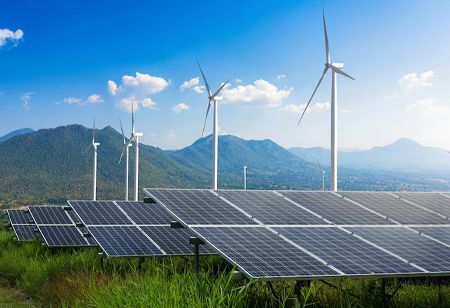
The Adani Group has announced a significant investment of approximately Rs.2.3 lakh crore by 2030 towards India's largest renewable energy expansion project.
This initiative will also include the addition of solar and wind manufacturing capacity, marking a major step forward in the company's ambitious growth strategy despite recent criticism from short-sellers.
According to a top company official, India's largest renewable energy company, Adani Green Energy Ltd, will invest about 1.5lakh crore to expand capacity to generate electricity from solar energy and wind power at Khavda in Gujarat's Kutch to 30 gigawatts from 2 GW currently and another Rs.50,000 crore in 6-7 GW of similar projects elsewhere in the country.
ANIL, a subsidiary of Adani Enterprises Ltd, plans to invest approximately Rs 30,000 crore to enhance the production capacity of solar cells and wind turbines in Mundra, Gujarat. AGEL, with its current operational capacity of 10,934 megawatts (10.93 GW), aims to achieve a renewable energy capacity of 45 GW by 2030. Notably, a significant portion of this target, 30 GW, will be developed at Khavda, making it the largest renewable energy project in the world.
Vneet S Jaain, Managing Director, AGEL, stated,"We have just now commissioned 2,000 MW (2 GW) of capacity at Khavda and plan to add 4 GW in the current fiscal (financial year ending March 2025) and 5 GW every year thereafter."
Jain also added that ANIL intends to increase its cell and module manufacturing facility at Mundra to 10 GW by 2026-27 from the current 4 GW in order to align with its plans and fulfill the needs of other domestic renewable energy companies and the export market.
Silicon crystals are transformed into solar cells that have the ability to convert sunlight into electricity. These cells are then assembled into modules and deployed in regions with high levels of radiation, like Khavda. The electricity produced is then connected to the transmission grid for distribution to consumers. In addition to solar production, ANIL is expanding its capacity to manufacture wind turbines that can generate electricity from wind, aiming to reach 5 GW within three-and-a-half years.
Adani Group, with a diverse portfolio ranging from seaports to electricity generation and transmission, natural gas distribution, mining, copper production, airports, data centers, and commodities business, has allocated a capital expenditure of a Rs.1.2 lakh crore for the fiscal year 2024-25 (April 2024 to March 2025). The group's renewable energy objectives are the most ambitious among corporate entities in the nation, aiming to produce 500 GW of electricity from non-fossil sources by 2030 as a component of a comprehensive strategy to achieve net-zero emissions by 2070.
Khavda, spanning across an area of 538 square kilometers, which is five times larger than the city of Paris, will have the capacity to produce 81 billion units of electricity at its peak. This immense power generation can supply energy to entire nations like Belgium, Chile, and Switzerland. AGEL has also established project sites in Rajasthan and Tamil Nadu. Situated in a desolate region near the Pakistan border, this colossal clean energy park is set to revolutionize power generation.
Jaain stated that the Khavda project would consist of 26 GW of solar capacity and 4 GW of wind capacity, totaling 30 GW. AGEL's current operational portfolio includes 7,393 MW of solar capacity, 1,401 MW of wind capacity, and 2,140 MW of wind-solar hybrid capacity.
With a current portfolio of 10,934 MW, capable of supplying energy to over 5.8 million households and preventing approximately 21 million tonnes of carbon dioxide emissions each year, this represents approximately 11% of India's total utility-scale solar and wind capacity. Furthermore, it contributes to more than 15% of the nation's utility-scale solar installations. Despite the allegations made by Hindenburg Research in January of last year, accusing Adani companies of share price manipulation and accounting fraud, the conglomerate remains unaffected as it continues to prioritize renewable energy initiatives.
With a current portfolio of 10,934 MW, capable of supplying energy to over 5.8 million households and preventing approximately 21 million tonnes of carbon dioxide emissions each year, this represents approximately 11% of India's total utility-scale solar and wind capacity.
Furthermore, it contributes to more than 15% of the nation's utility-scale solar installations. Despite the allegations made by Hindenburg Research in January of last year, accusing Adani companies of share price manipulation and accounting fraud, the conglomerate remains unaffected as it continues to prioritize renewable energy initiatives.
We use cookies to ensure you get the best experience on our website. Read more...
Copyright © 2025 HomesIndiaMagazine. All Rights Reserved.